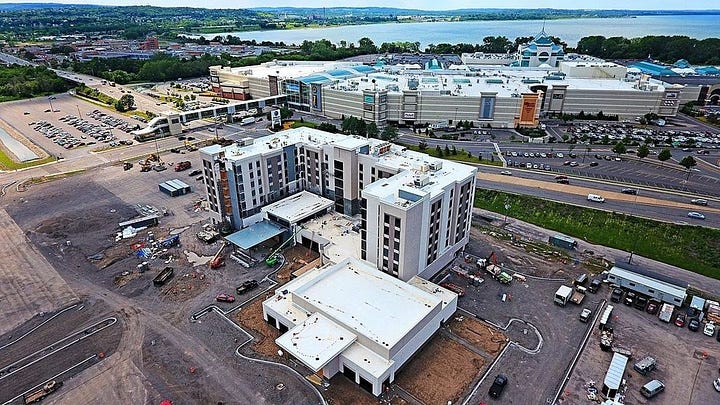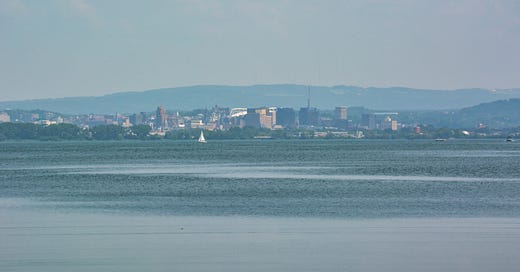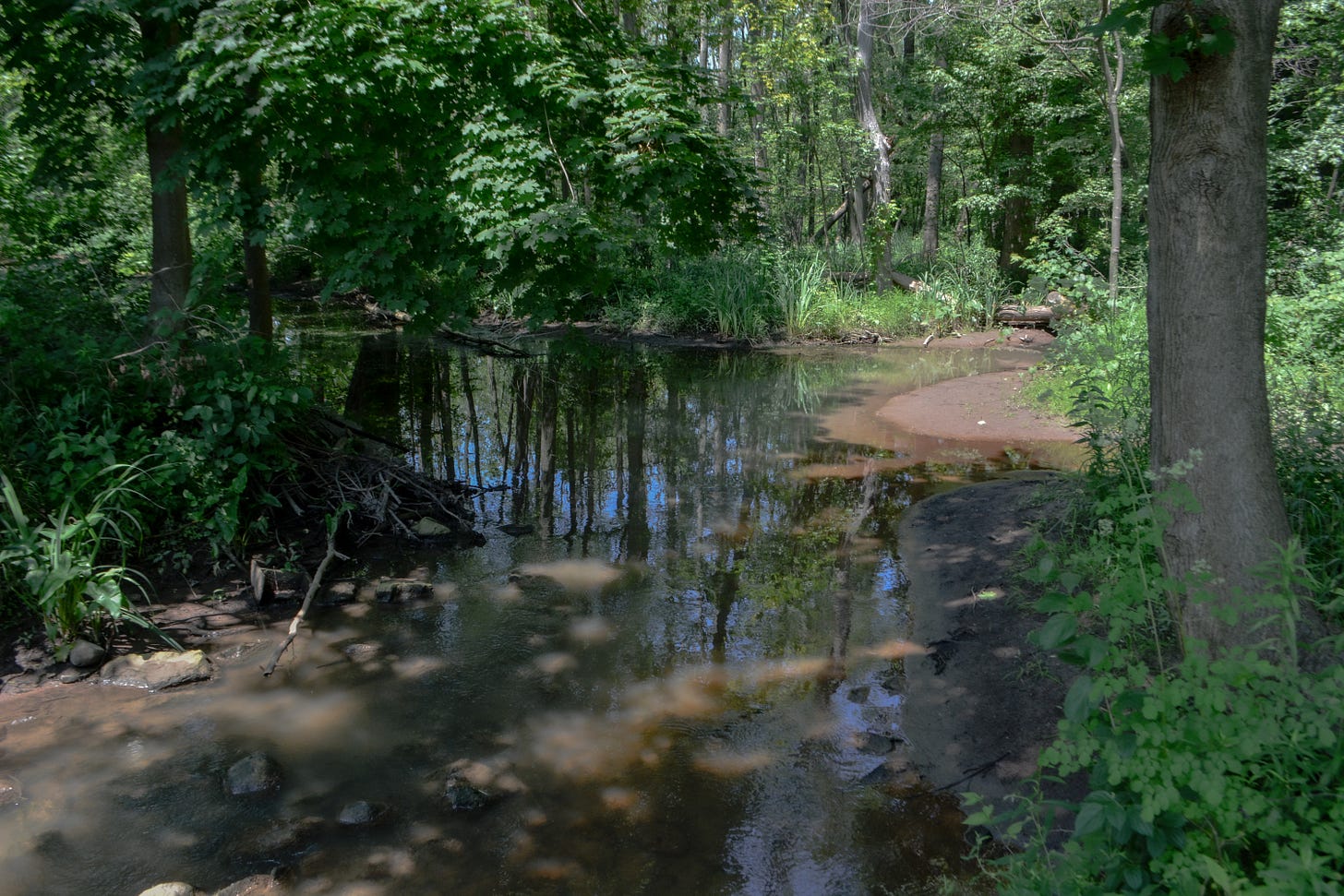Today I want to share a very special place with you: Onondaga Lake. It’s a shallow, medium-sized body of water stretching 4.5 miles long and 1 mile wide, with a maximum depth of just over 60 feet. The Lake lives in the centre of Onondaga County — a settler jurisdiction named after the Onondaga Nation. The first 15 years of my life where spent never too far from this lake, whose complicated story speaks to the history of Syracuse as much as the entire United States.

First and foremost, Onondaga Lake is the heart of the Haudenosaunee Confederation. The Onondaga have called the hills and valleys surrounding the Lake their home since time immemorial. At the point of European contact, the Onondaga held major longhouses on the south end of the lake, along Onondaga Creek. This creek is one of only two tributaries feeding into the Lake. When I visited the Great Law of Peace Centre during my trip to Syracuse this past July, I learned that the north shores of Onondaga Lake were where Great Peacemaker gathered the Five Nations to plant the Tree of Peace and establish the Haudensaunee Confederation. Learn more about the founding of the Haudenosaunee Confederation on the Onondaga Nation’s generous webpage, here: https://www.onondaganation.org/history/.
Growing up in Syracuse’s suburbs, I was fortunate enough to learn about Haudenosaunee history from a young age. Thanks to the care of my teachers or school district’s curriculum developers (which I don’t know) this history was always presented as a living history — not one that ended upon european contact. But this education didn’t touch on the Lake.
The story I learned about Onondaga Lake was one of industry. Specifically, I learned about the salt industry that put Syracuse on the map in the pre-refridgerator world and the factory industries that filled Onondaga Lake with mercury and other toxic chemicals over the course of the 20th century. As salt extraction led to heavier chemical industries, the Lake became more and more polluted to the point that the recreation that grew up around the Lake in the mid-19th century (an industry in itself) almost completely vanished. In Syracuse you often come across century-old photographs of white folks bathing in Onondaga Lake, something you wouldn’t see today.
One of my family’s traditions growing up was to bike up and down Onondaga Lake Park, on the lake’s northeast shores. I recall the strong wastewater smell, the “NO FISHING” due to mercury pollution signs, and being warned never to touch the water because of E. coli and whatever other microbes made their home in those waters. At that time around the turn of the 21st century, industry had all but left Onondaga Lake, but its smelly trace remained. I nevertheless enjoyed these bike rides and, in them, grew a deep appreciation for this ecosystem.
(Later I would learn that the Metropolitan Syracuse Wastewater Treatment Plant accounts for 20% of the Lake’s annual inflow — the highest percentage of wastewater for any lake in the United States. Yikes.)
Every bike ride, I would stop to explore a small stream and pond tucked behind tall grasses and trees along the path. I remember watching how the water moved slowly toward the lake, how the foliage shadows danced, and the ants and dragonflies and frogs and chipmunks made their ways through the world of this stream. I imagined the pond from the ant’s perspective — how limitless and grand this landscape must have been for them! This ordinary landscape was, for me, an introduction not only to the ecology but also to the mystery of the natural world.
When I returned to Syracuse on my own this past July, I made a point of renting a bike to visit the stream, in addition to the many other sights along Onondaga Lake I remembered from my childhood. In a following post, I’ll share some poems I wrote during my visit.
What’s most compelling to me about Onondaga Lake is its testimony to the entanglements of Indigenous sovereignty, urbanization, industry, recreation, and commerce. Onondaga Lake has witnessed it all. Studying its story is like tracing the history of North America.
All throughout my childhood, I remember seeing flashy plans for the transformation of Carousel Center (a mall where I spent much of my early years) into Destiny USA. Carousel Center was built in the late 1980s as a regional shopping centre on the south tip of Onondaga Lake. Right next to the mall runs the mouth of Onondaga Creek — not far from the site of the Onondaga Nation’s former longhouses and the capital of the Haudenosaunee Confederation. Aptly enough, the main street servicing the mall is named “Hiawatha Boulevard.”
At some point in the early aughts, plans were proposed to transform Carousel Center into a hub for international shopping and recreation called Destiny USA. I remember these plans included new additions to the mall, shiny green glass-façade towers, a five-star hotel, golf course, and even new (swimmable!) beaches on the west shores of Onondaga Lake. I also recall that the plan for Destiny USA was wrapped up in remediating the Lake’s toxicity so that people could (or would even want to) use it for recreation again. Nostalgia for Syracuse’s late-1800s ‘glory days’ as a centre of commerce and tourism was clearly at the root of these aspirations. For a small rust belt city, Destiny USA seemed like Syracuse’s golden ticket into the 21st century.
Then the crash. 2008/009/010 hit Syracuse hard. The city’s remaining few factories closed shop (including the one that provided for my family), homes foreclosed, people struggled and many ended up leaving town. My family moved states and the construction of Destiny USA halted.
(I found a chronology of Destiny USA that gets into all the juicy details for those who want the full story, here)


Fast-forward over a decade, and I return to the shores of Onondaga Lake. Destiny USA is a sorry shell of the new city-on-the-lake we were promised in my youth. On a balmy early July morning, it’s impossible not to smell the pungent wastewater aroma wafting in on the warm breeze. There are dragonflies, joggers, a family of ducks, and even a sail boat enjoying the Lake despite the fact that, after all these years, the water remains toxic.
In a real way, Onondaga Lake is a case study for the trajectory of the United States, from land dispossession to settlement, urbanization, industrialization, de-industrialization, and the rise of neoliberalism.
Nevertheless, Onondaga Lake is still here. It’s still doing its lake thing — receiving, reintegrating, and reflecting back at us. We just have to be there to witness.







